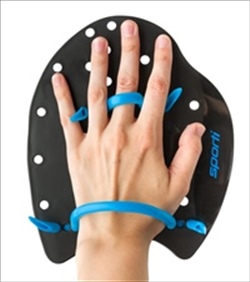Understanding the Difference Between Swim Resistance Gloves and Swim Paddles

The broad category of “pull gear” in training accessories is primarily meant to engage your upper body, emphasize arm strength and generally de-emphasize your legs -- or even eliminate their forward propulsion all together for certain drills.
For most pull sets, you will wear a pull buoy to help elevate your legs while they’re inactive, and some type of paddle or resistance glove.
Both paddles and gloves are used to create more resistance between your hands and the water, enabling you to propel quicker without the aid of kicking. While gloves and paddles serve a similar purpose, they’re actually vastly different.
In this guide, we will briefly explain the key differences between swim resistance gloves and swim paddles, and the benefits of both to help you decide which ones are right for you or how both can help you in different ways.
Swim Resistance Gloves
 Like a standard swim paddle, swim resistance gloves are mainly used to increase resistance and build upper body strength.
Like a standard swim paddle, swim resistance gloves are mainly used to increase resistance and build upper body strength.
The main difference is that while swim paddles are made of plastic, swim gloves are generally composed of neoprene. Swim gloves look and fit like a glove, but feature webbing between each finger to really help grab the water with each stroke. Because of their softer, more flexible nature, you still get a lot of natural mobility in your hands while pulling.
Due to the flexibility, and freer range of motion, swim resistance gloves are a great option for swimmers who often swim breakstroke or butterfly. Running through those strokes with standard swim paddles can cause shoulder injuries if you’re not careful. Swim gloves are also excellent for water aerobics and fitness classes to add resistance.
Swim Paddles
Most people are probably more familiar with standard swim paddles. Although they come in various shapes and sizes, they’re the most common piece of pulling equipment on the pool deck, and likely something you’d incorporate into your training. Like swim resistance gloves, they help to build strength in your arms and upper body by creating resistance during your stroke pull.

Swim paddles are made of durable plastic and often feature a silicone strap around the fingers and wrist to secure them in place. They come in various sizes from just larger then the hand to something the size of a small lunch plate.
The technology for swim paddles is constantly evolving, and brands are always coming out with new revolutionary designs based on fit, stroke and technique. For example, you may find a paddle without silicone straps and holes for your thumbs and fingers to slide through instead.
Since swim paddles offer less mobility, and less room for error, they really force you to hone in on your stroke technique and finger entry into the water. If your fingertips enter the water crooked, it can throw off your whole stroke, which can lead to injury. That being said, paddles help you to avoid this as much as possible by providing instant feedback on your forearm catch (if your forearm catch is off, the paddle will slip off), finger positioning, and feel for the water.
For entry-level and less experience swimmers, swim paddles are ideal for freestyle and backstroke. You will find that even without kicking, you can move quickly and efficiently through the water. For more experienced swimmers, paddles are great for improving speed, technique and muscle definition, and are typically used during all four of the strokes.
No matter which option you choose, resistance gloves or paddles, they both mix up your workout and teach you the power of controlled speed for your arms and upper body.
Shop Swim Paddles And Resistance Gloves
